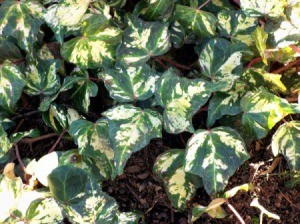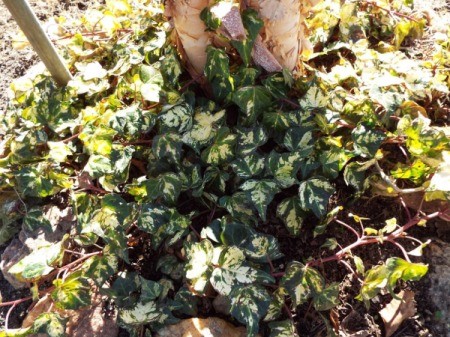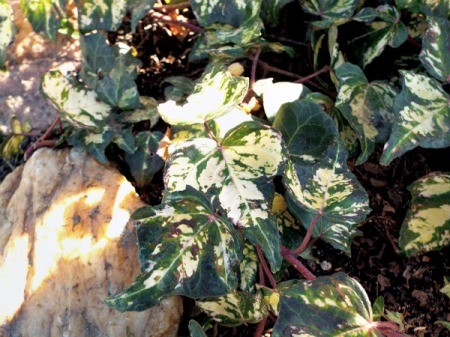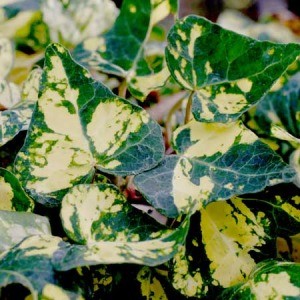
 I bought a 3 inch pot of this ivy from a local nursery. I have rooted many pieces and am making small beds of it, here and there. When I bought the ivy, none of the pots had name tags on them. I asked the sales lady the name of the ivy. She said she didn't know.
I bought a 3 inch pot of this ivy from a local nursery. I have rooted many pieces and am making small beds of it, here and there. When I bought the ivy, none of the pots had name tags on them. I asked the sales lady the name of the ivy. She said she didn't know.
I sent a picture of the ivy to a national ivy organization. They invited questions about ivy. They never answered my email. I'm hoping some fellow member might know the particular variety. The variegation varies quite a bit, so I am posting three pictures.


Add your voice! Click below to answer. ThriftyFun is powered by your wisdom!
I believe you might have hedera helix "Kolibri" ivy, a variegated Ivy.
Here's a picture similar to yours. www.google.com/
Thanks, Abigail,
But if you go back to the Kolibri, there is one right beside it called Midas Touch. It looks even more like mine. Take a look and tell me what you think.
This is weird. Here is the picture your link lead me to. It says:large-Hedera helix Kolibri Ivy, But it looks nothing like mine.
I looked further and found this picture. It says: Hedera helix 'Midas Touch' Ivy 'Golden Kolibri' Ivy.


You were right. I read further and found that this Danish introduction was once called Kolibri, but now it is called Midas Touch (Golden). It was Ivy of the year for 2016. But, I don't believe it is new.
And here is more: This Beautiful Danish introduction was first imported to Great Britain in 1993 by the Frode Maegaard Hedera Nursery of Ringe, which listed it as Golden Kolibri, an unaccepted name under ICNCP rules which preclude prefixes to existing names, such as Kolibri. Mr. Stephen Taffler of the British Ivy Society suggested the name Midas Touch, and a new ivy was named.
Thank you so much, Abigail. I'm sure this is it. I would have never found the name without your help.
in order to properly identify a plant, you really need to be near it, see the colours up close, see the shape and morphologyof the stem, the shape of the leaves, its behaviour (does it climb, droop, etc), etc. Some even break off pieces of leaf to see what colour, odour, etc comes out. Without all this information, it is hard to pinpoint exactly what type of ivy it is.
Here is a guide, for instance, as to the leaf morphology which can help identify what type of ivy it is. Two photo images show up in the photos section with different leaves next to the scientific nomenclature of the variety of plant: www.polyploidevolution.com/
and here that ivy.org site provides images of different kinds of ivy: www.ivy.org/
I have bought so many varieties of ivy, I have lost count. Often while comparing two varieties side by side in the garden center, I find no discernible difference, whatsoever.
I'm thinking if this were a legal issue, the only evidence acceptable as proof in a court of law would be the results of a DNA analysis.
Love the couple's cold frames.
I love Ivy of all "kinds" and now have more than I can count but many are running together so it is difficult to really tell where one begins and another ends as so many are very similar.
I did purchase a small one that still has a tag and it says Midas Touch and it certainly resembles this plant so maybe that is correct.
It is nice to see all of the Ivy sites and photos so I hope everyone will check out the links others have provided.
It is a variegated ivy which is beautiful.
As to the name of the ivy shown in the ThriftyFun picture, it would be near impossible to identify an ivy variety by a small picture, as well pointed out by ahorrasi.
This being a larger landscape planting, it is likely to be Hedera helix, the common English ivy. It is less likely to be a hybrid or cultivar, as those varieties are usually reserved for smaller applications.
True to form, I break the rules. I have banks planted in Little Herman, Mini Adam and maybe Midas Touch. And for ground covers, I have Spearpoint, Millennium and others.
Add your voice! Click below to answer. ThriftyFun is powered by your wisdom!